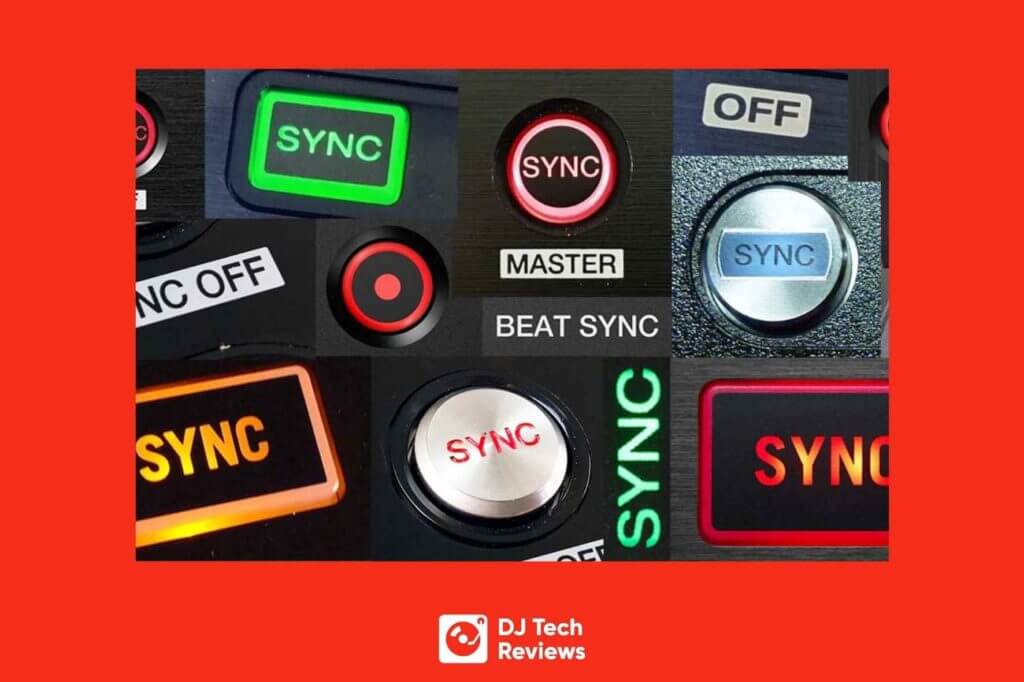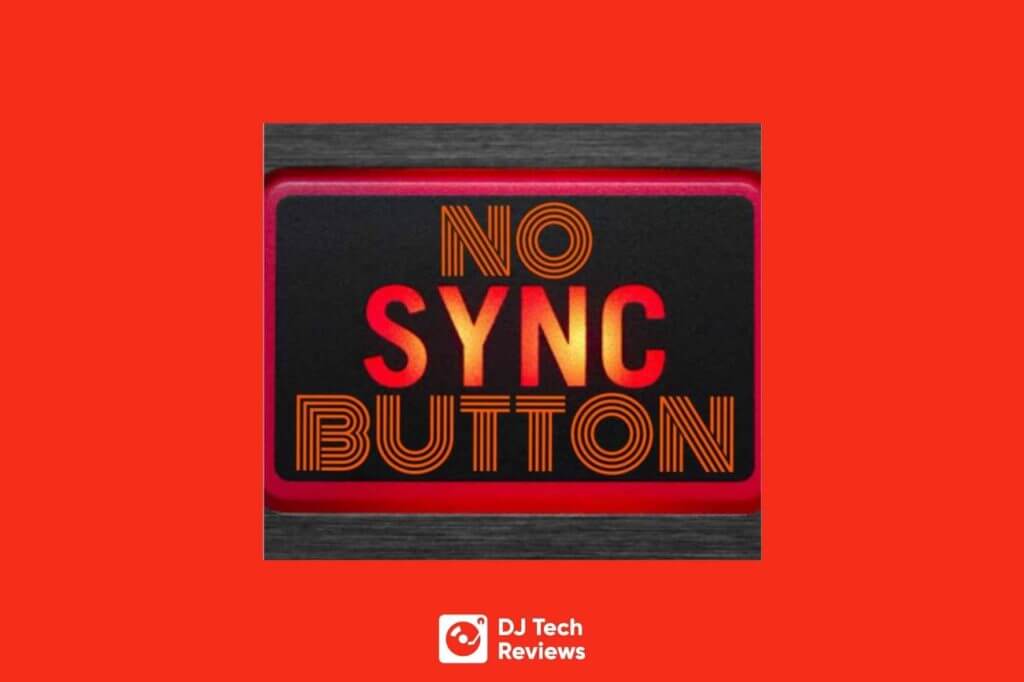While it’s a little less prevalent on the cheaper and lower-end DJ controllers, if you’ve got yourself a quality bit of DJ hardware, you’ll likely notice a small yet interesting button with the word “SYNC” attached to it.
What’s interesting is that, depending on the person you ask, this sync button can be considered an incredibly useful feature or a frustrating addition that mires the prestige of DJing.
In this article, we’re going to get into the ups and the downs of the sync button as well as the best times to use it while performing.
But first, let’s put this out there from the start, using SYNC doesn’t make you a bad DJ or a good DJ.
I repeat, “using SYNC doesn’t make you a bad DJ or a good DJ“.
There are absolutely times when SYNC will help you rock a dancefloor. So don’t be a “Negative Nancy”, embrace technology and use it to your benefit.
What Is The SYNC Button? (in short)
Short for “synchronization,” the sync button works by allowing the DJ to automatically beat-match between two different tracks. This is done by using either a DJ controller or a laptop while using one of the different types of DJ software gear.

Read this next: How to Beatmatch properly: The Ultimate Guide
DJing With The SYNC Button…or NOT?
By using the sync button, a DJ can instantaneously, at the press of a button, achieve a near-perfect beatmatch. More to the point, they can do this completely without having to manually adjust things with the jogwheel or the pitch shift. It also doesn’t require the constant use of listening-in via one’s headphones and speakers.
More established DJs often use the sync button to better offer them the ability to perform more complex and creative DJ performance options when transitioning between the two tracks.
As an example, a DJ could use the sync button when performing three or four deck mixes, which may also include dropping acapella’s or samples.
For beginner DJs, using the sync button is an excellent option for those needing help putting together DJ mixes in the first place.
And, while they shouldn’t be solely relied upon for beatmatching (more on that later), sync and the sync button can grant a ton of useful support when someone is just starting or dealing with a technical issue.
When To AUTO-SYNC?
There are several different times when using the sync button makes absolute sense.
It’s an ideal option when dealing with technical issues, beatmatching a track with different BPMs, or when you’re planning to scratch or use a turntable. You can also use the sync button if you’re having trouble catching the beat through your headphones or your booth monitors are poor.
Below, we’ll go more in-depth with each of these examples so that you understand when you should (and when you shouldn’t) use this feature.
Reason #1. Technical Challenges
One of the biggest reasons any person is likely to find themselves using the beat sync (beginner or expert) is if there’s some type of technical problem with your hardware controls.
For example, let’s say your CDJ tempo controls are off or the CDJ you have simply won’t let you control your pitch.
In these instances, you’re going to find it incredibly difficult to organically beatmatch without using the sync beat button.
While this isn’t going to be the most prominent reason for using the sync button, it will force every type of DJ to use it, regardless of how you normally feel about it.
It’s a reliable safety net.
Reason #2. Beatmatching With Different BPMs
The second, more prevalent reason you’re likely to deal with this is if you’re planning to beatmatch with tracks that have two different BPM speeds. So long as the speeds aren’t too far apart from one another, the sync button can be a serious help in locking two beats together that otherwise would be too much hassle manually adjusting.
This is primarily used by DJs that are just starting out or like the convenience of not having to do the process of manually aligning tracks together.
However, many professional DJs that are more experienced will go through the process of manually shifting for a more precise alignment.
Reason #3. Scratching
If you are a scratch DJ or a fan of using turntables, the sync button is a very useful option for immediately jumping into the groove of things without the constant back and forth on your end.
Still, this pretty much starts and stops when it comes to DJs that like to scratch, regardless of their skill or experience level.
For experienced DJs that aren’t particularly into scratching, the amount of time saved isn’t worth the potential for an off-cue sound mix because the beats didn’t match up perfectly.
Reason #4. Difficulty Hearing Through Speakers
Lastly, when it comes to speaker and monitor issues, this is another time virtually all DJs will opt for the sync button instead of trying to sync them up manually.
If a DJ is having a rough go of hearing the audio coming out of the booth monitors or from their headphones, they may instead opt for the quick and easier method of using the sync feature.
The reason hearing is so vital when it comes to aligning two alternative track beats should be obvious.
By not being able to hear the music, you’re not going to be able to hear the beat either. This makes beatmatching by ear incredibly difficult, thus making transitioning between tracks that much more difficult – often leading to a pair of sounds “galloping” against one another.
Read this next: How to Repair Speakers: The DJ DIY Guide

Where Is The SYNC Button Located?
Depending on the hardware you’re using, the sync button can be found in one of many different places. Just as well, each model or version of each device can similarly have the sync button found in a different place. With that in mind, here are the places it is most likely to be based on the type of device you’re using.
CDJ
For a CDJ setup, the sync function is generally pretty universally set, unlike for the DJ controller. As such, expect to find it left of the jogwheel.
This is especially the case for Pioneer DJ CDJs.
One thing you’ll notice is that a Pioneer DJ CDJ will also have a “Master” button to its right. The Master button works by ensuring that both tracks are properly highlighted before being synced together.
You’ll want to make sure that when you want to sync two tracks, the Master button is selected, as this will make sure the second track has a proper BPM reference point from the first track.
DJ Controller
The first and most likely method that most DJs today will use the beat sync button is via the DJ controller.
Keep in mind that this is only going to be found on the mid to higher-end versions of the DJ controllers, with lower-end models simply not having the ability to support the feature.
When it comes to the majority of new controllers, the beat sync button will generally be prominently displayed on either deck channel and will vary based on the specific device you’re using. It’s also important to note that your controller will be working alongside whatever DJ software you’re using, so you’ll generally have two entirely separate ways to use the beatmatching option.
DJ Software & Laptop
Last up is using the beat sync button on your laptop while using DJ software.
As with the DJ controller, where it’s designated will vary based on the type of software you’re using. For example, the Rekordbox software puts the “Beat Sync” feature in the same vicinity as the BPM and cueing section of your screen.
In addition, the beat sync option will be joined by the Master feature. This feature works similar to the way it does on your CDJ, which essentially ensures the two tracks can properly sync with one another.
Read this next: Essential DJing Transitions (Made Simple!)
SYNC Button: The Pros
There are many different positives about the beat sync feature that make it worth learning about and investing your time in.
From giving you confidence in your ability to get a pair of tracks mixed to be a great backup plan in case of an emergency, the beat sync button option is incredibly useful and something certainly worth at least considering.
PRO #1. The DJs Safety Net
The first (and arguably biggest) reason you should consider making the sync button something worth playing with is how it works as an overall backup plan and safety net.
Whether you’re just learning and don’t have the beatmatching down perfectly, dealing with faulty equipment, or simply don’t have time to do it manually, leveraging knowing that, with the press of a button, you can use the sync feature grants a massive sense of relief and assurance that the set will go ok.
While I would certainly implore that you learn beatmatching by ear, and use that method when possible, having this in your back pocket “in case of” any type of emergency or technical catastrophe.
PRO #2. Pushing the Boundaries
Using the SYNC button can also allow you to take DJ trickery and magic to the next level. Using SYNC will allow you to mix with 3 or 4 decks whilst also blending in samples and utilizing other DJ equipment.
Without the SYNC button this would be very challenging and only a very small percentage of DJs would have been able to reach this level of DJ performance.
PRO #3. Embrace DJ Technolgy
It may not seem like a huge thing in the beginning, but by understanding how the newest pieces of technology are used, a DJ can constantly stay “in the know” for other technological advances in DJ equipment.
For example, while most newer DJs generally won’t have an issue with the sync button and its use, the same isn’t true for older DJs that have been around for a while and haven’t learned how to use some of the newer features offered to the DJ equipment.
Simply put, by understanding and using the beat sync button option, you ensure you constantly know what DJ equipment is good and how it may soon be evolving.
I repeat, do not be a “Negative Nancy”!
PRO #4. Energy Saver
Another huge area where the sync button is useful is for longer DJ sets or gigs.
While smaller, one or two-hour events may not be so bad, this is much less the case as it pertains to longer gigs, which can often go for upwards of three to five hours.
By having the sync button as an available option, a DJ can have the right amount of headspace while being better able to conserve their energy when it comes to beatmatching, and use it more on the other, more important things, like keeping the crowd engaged in the performance.
PRO #5. DJ Confidence
Lastly, and most importantly, the beat sync button ultimately offers you a level of confidence and assurance that you’d otherwise not have when hopping on stage and dealing with a raging crowd. This confidence comes in two forms.
The first way the beat sync button affords a DJ confidence is if they are just getting started.
If you’re a beginner DJ and have only just begun performing gigs and doing sets in front of a crowd, it can be more than a bit nerve-wracking as an experience. That sense of insecurity can be more than enough to throw you off your game while beatmatching by ear, if even for just a second or two.
Having the sync button as a safety option, not only insures you don’t make a mistake, but the fact that you even have it as an option can work as a subtle reminder that you don’t need to be perfect and that you can rely on some of the extra features with your controller or software.
I assure you, this was not the case in the original Vinyl days. If you made a mistake, it was purely down to your skill level to pull it back.

SYNC Button: The Cons
So far, we’ve touched on all of the useful points of beat sync and the sync button. However, just as there are many useful aspects to the feature that makes it appealing for some, there are many different aspects about it that make the feature less than favorable for others.
CON #1. Anyone Can DJ Using SYNC
The biggest reason why anyone is resistant to the beat sync feature, the fact of the matter is that it ultimately can lull a DJ into this false sense of thinking they actually know how to DJ when, in fact, they’re simply pressing a button.
This is especially tough for older and younger DJs. Older DJs have spent the bulk of their time doing things the old-school way, where they had to mix by ear.
Meanwhile, younger DJs have almost always had beat auto-sync options available to them from the start and may have never needed to mix by ear.
Both groups may ultimately walk away from sync button options with a poor taste in their mouth because of their crazy level of simplicity.
CON #2. It’s Not A DJ Replacement
Importantly, the sync button doesn’t DJ for you.
We touched on it a bit earlier, but the reality is that the sync feature is just that. It’s a feature. The same as using an FX, a loop, or playing with the EQ filters. Pressing a button to sync beats together doesn’t do anything more than sync two tracks’ beats together.
Everything else is still on you.
CON #3. Not Always Effective
Thirdly, the sync button doesn’t always work.
Depending on the Tempo or BPM of each track, there are more than enough instances where the feature just doesn’t work and leaves a DJ with a jumbled, galloping mix. Nightmare.
The problem is that, if you’re not trained in performing by ear, or if you’ve become far too reliant on it, that may be all you know, meaning you likely will leave it as is.
CON #4. Doesn’t Work For All Genres
Lastly, auto-beat sync options are also simply not good for every type of genre out there. Particularly for the older genres (like Disco and Funk) where live drummers have been used instead of a drum machine.
In these cases the BPM will be a little erratic and not “bang on”, a beat-syncing software is going to have a terrible time trying to line the two tracks up with one another.

Read this next: Cue Button vs The Hot Cue (What Does The Cue Button Do on Mixer?)
Using The SYNC Button: Takeaway
We finish with our SYNC button takeaway. Beatmatching is one of the core fundamentals when it comes to being a DJ and mixing music. No matter what form it takes, it will always be an essential feature that must be performed if you plan to perform on stage.
With the advent of technology, we’ve found a way to largely automate that normally energy-exhaustive process and make it so that anyone can sync beats with the literal push of a button.
By knowing how the sync button operates, what are its pros and cons, and when the optimal time is to use it, you can decide for yourself if you’d rather take the time to learn and use beatmatching by ear for a tighter and better sound, or take a bit of a risk for a faster and more automated process through the sync button.
Related Articles
- Best In-Ear Monitors (2024): Top Picks from Sennheiser, Shure, and More
- Best DJ Headphones (2024): Expert Picks from Sennheiser, Pioneer DJ & More
- How to Beatmatch properly: The Ultimate Guide [2024]
- Airpods Hurt My Ears! Are Apple AirPods Bad For Your Ears?
- Cue Button vs The Hot Cue (What Does The Cue Button Do on a Mixer?)




